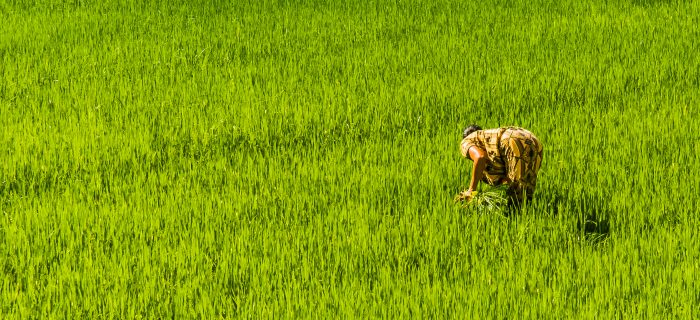Gender Injustice and the Cultivation of Industrial Agriculture
Photo by JonyBraker / CC BY
While globalization and industrialization of the food system has resulted in fewer farms and farmers, the number of women farmers in the US is increasing—and they’re fighting against a system that fails to serve them and their communities. Women are taking control of their food systems by farming, organizing in their communities, and advocating for systemic policy change that can create food systems that are better for farmers, workers, their communities, and our planet. Despite an increase in the number of women farmers, however, there is not a parallel trend in representation or power; women rarely control or hold power in the agriculture and food industry as a whole, and exploitation is rampant, especially among women of Color.
In light of International Women’s Day, let us delve further into how patriarchy is integral to our food system as we know it—most notably characterized by 795 million chronically undernourished people in the world, most of which are women and girls (despite the fact that women participate in the production and processing of food at roughly equal rates to men).1 Thus, to end hunger and malnutrition, we must end the injustices in the food and agriculture system—many of which are gendered. In fact, the unpaid and underpaid labor of women is the foundation of our economic and agricultural system as we know it.
The number of US women farm operators has grown by nearly 300 percent since 1978, with many of these new farmers operating outside of male-dominated, profit-oriented conventional agriculture.2 However, women farm operators as a whole receive 61 cents to the dollar made by men. Thus, when controlling for farm assets, work time, age, experience, farm type, and location, women generate nearly 40 percent less income than men—among the largest wage gap for any occupation.3 This wage gap is worse than (but reflective of) wage gaps workforce-wide.
Structural gender-based oppression, or patriarchy, characterizes the food and agriculture sector. No matter the sector of work, however, women’s earnings are lower than those of men. The intersection of gender, race, and class in part determines where workers are located, what type of work they do, and under what conditions. In the US, a gendered and racialized wage gap persists. Latino women are paid just 63 cents for every dollar men are paid, Black women are paid 70 cents for every dollar men are paid, and white women are paid 84 cents for every dollar men are paid.4 Thus, the distribution of food insecurity is inequitable as well; 30.3% of US female-headed households are food insecure, while only 22.4% of male-headed households are food insecure.5 These statistics reflect deep structural injustices, integral to the formation of today’s economic (& food system).
In every part of the world, women have played an integral role in the production, processing, and preparation of food. However, as agriculture industrializes, women are oftentimes left out of capital-intensive forms of agriculture, prevented from accessing formerly communally held land as land is owned and transferred patrilineally.6 This is reflected in US agricultural wage gaps—women who do participate in industrial agriculture face far-worse wage gaps in comparison to men. As land is privatized, stricter gender roles are enforced as men are appointed owners of land, and thus, capital and its associated privileges. Men are considered “farmers”, while women are considered “farmwives”.7
However, the often-heralded family farm is entirely dependent on the typically-unpaid labor of women, including sexual reproduction and the feeding, clothing, and maintaining of households in addition to the direct planting, harvesting, and caretaking of crops, livestock, and land. It’s not that women aren’t working in the production and processing of food in the industrial agricultural system—it’s that their work is not recognized or valued in this system. Thus, they are demoted to the economically and socially devalued roles of wives, field workers, domestic workers, processors, bookkeepers, and more.
Stay in the loop with Food First!
Get our independent analysis, research, and other publications you care about to your inbox for free!
Sign up today!It’s not just that women need to “catch up” with men. The inequitable position of women in the food system is actually part of what makes the food system work. Women are subsidizing industrial agricultural profits; like other industries, industrial agriculture maximizes its profits through the extraction of surplus value from women.
Although women are often in precarious locations in the food system, it has not inhibited their leadership of food and agriculture-related activism. This is most visible in the movement for a more just, sustainable, sovereign food system, where women work to grow food, organize their communities, and change policy in order to build a food system that works for all of us—ultimately transforming the very systems upon which our industrial food systems depends. Let’s follow their lead.
1 Asian Development Bank (2013). Gender Equality and Food Security–Women’s Empowerment as a Tool Against Hunger. Mandaluyong City, Philippines: Asian Development Bank.
2 Pilegram, Ryanne and Bryan Amos (2015). “Beyond “Inherit or Marry It”: Exploring How Women Engaged in Sustainable Agriculture Access Farmland.” Rural Sociology 80: 16-38.
3 Paul, Mark and Anders Fremstad (2016). “Opening the Farm Gate to Women? Sustainable Agriculture in the United States.” Working Paper Series. University of Massachusetts Amherst: Political Economy Research Institute.
4 US Bureau of Labor Statistics (2015). “Women in the Labor Force: a Databook.” Report 1059.
5 Coleman-Jensen, Alisha, and Christian A. Gregory, Anita Singh Matthew P. Rabbitt. “Household Food Insecurity in the United States in 2015.” ERR-215, Economic Research Service, US Department of Agriculture, September 2016.
6 Haiven, Max. Interview with Silvia Federici (2009). “Silvia Federici: On Capitalism, Colonialism, Women, and Food Politics.” Politics and Culture.
7 Shortall, Sally (1992). “Power Analysis and Farm Wives.” Sociologia Ruralis 32(4): 431-451.


 Help Food First to continue growing an informed, transformative, and flourishing food movement.
Help Food First to continue growing an informed, transformative, and flourishing food movement.




